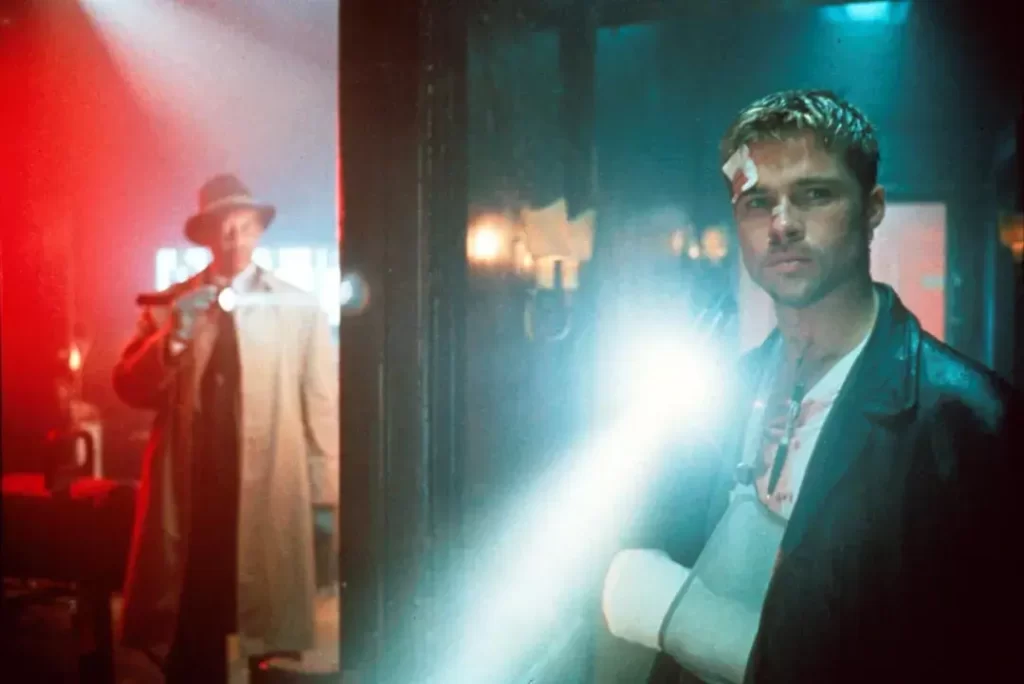The cycle of crime and punishment: the perpetrator, the punisher and the public
The story takes place in an unknown city where it rains all day.

Somerset was a veteran detective who was a week away from retirement, and Mills was the brash rookie to replace him. Somerset is eager to make it through the last week, but the two are soon drawn into an unprecedented serial killing.
The killer wrote “gluttony” on the wall after killing an obese man. Somerset realized that this was one of the seven deadly SINS of the Divine Comedy, and that it was most likely a serial murder.
Sure enough, there were several murders in the following days, and on the walls were written greed, laziness, lust, and pride.
Somerset and Mills after thousands of hardships finally found the murderer John’s residence, unfortunately is the murderer successfully escaped, in the desperate time, the murderer surrendered.
John calmly arrived at the police station, confessed to all the crimes, said there are two bodies, and asked Somerset and Mills together to get back, or his lawyer will help him escape punishment on the grounds of mental problems.
When the three men reached the wilderness, they did not see the body, but a Courier delivered the head of Mills’ newly pregnant wife.
John calmly said to Mills, who pointed the gun at him: “The sixth sinner is myself, I envy you for your beautiful wife, your happy life, I envy you for everything, and now you can be angry.”
Mills trembles in grief, and Somerset tries to dissuade him, because what John wants most is for Mills to kill him himself, so that Mills will commit the sin of anger and help John complete all seven deadly SINS.
In the end, Mills pulled the trigger. He not only killed John’s body in the moment of shooting, but also destroyed his own mind.
The Cycle of Life and Death: The Unborn Child, Mills and Somerset
The cycle of crime and punishment described above, though somewhat obscure, can be deduced after careful consideration because it is closely related to this striking ending.
But then this second cycle, which appears at every moment of the film, is completely imperceptible.
Seven is a standard two-lead movie, which anyone can tell, but why make it a two-lead movie?
In addition to conflicts between the protagonists, keeping the entire film at key nodes, and maintaining dramatic tension, the setting of the double protagonists has a more important meaning
In a way, Mills and Somerset are the same person.
Mills was like a man in his youth, naive and impetuous, but idealistic and convinced of justice.
Samosat is like a man in his old age, experienced and unhurried, but recognising the reality and acknowledging the darkness.
There is a scene in which two people talk in a bar, which is the best proof of this view.
The two talked about Somerset’s retirement, Somerset helplessly said that the human sin has been irredeemable, leaving is a necessity.
Mills couldn’t help but interrupt: “You’re not leaving because you think the city is dark, but because you’re retiring and you’re thinking and saying that.”
Somerset was silent for a moment, smiled helplessly, and said nothing.
The conversation is like that of a father and son – Mills seems young and energetic, disdainful of his shrinking young son.
Somerset seemed to be an old father who had seen all the vicissitudes of life and was cautious and conservative, and knew that he could not change his child’s mind, so he had to let it go.
Somerset looked at Mills as if he were looking at his younger self.
So between Mills and Somerset, there is also a hidden cycle from youth to old age.
But in addition, there is a scene that is extremely easy to overlook.
It was one morning when Mills’ wife, Trish, met with Somerset alone. She was pregnant, unsure whether she should have the baby, and hesitant to tell her husband.
Somerset saw that Tracy had accompanied her husband to this strange, oppressive city alone, with no relatives, and her husband was still walking on the line of life and death every day, and the mental pressure was great, so she told her past.
“I had a relationship a long time ago that almost led to marriage,” Somerset said. The girl was also pregnant at the time and asked me if I wanted to have the baby, and I thought about it and said no.
And every day since then, I think about what would have happened if that child had been born.
But even as much as I wanted that child, I knew I had made the right choice.”
At the end of the film, when John kills Tracy, he also kills this life that has not yet come to the world.
And this life that did not come into the world, Mills, Somerset, constitutes the complete cycle of life and death.
You can think of it as this logic:
Ignorance of everything (unborn child) → Belief in ideals (Mills) → surrender to reality (Somerset)
It can also be interpreted as this logic:
Love the world (Mills) → Recognize the world (Somerset) → Give up the world (unborn child)
Actively or passively, both sets of parents made the same choice: not to bring their offspring to earth









